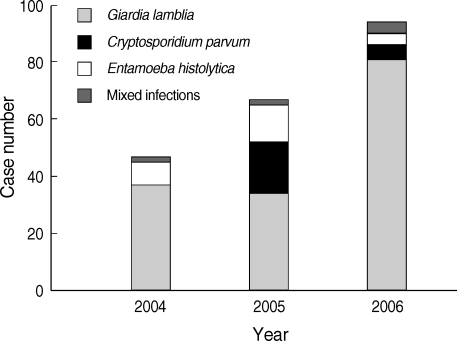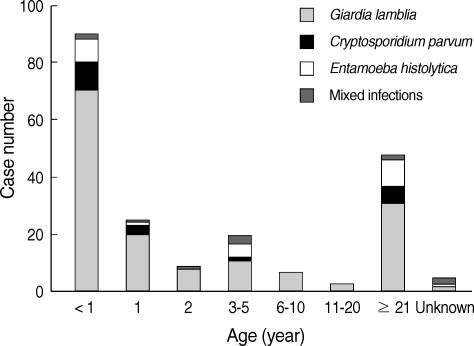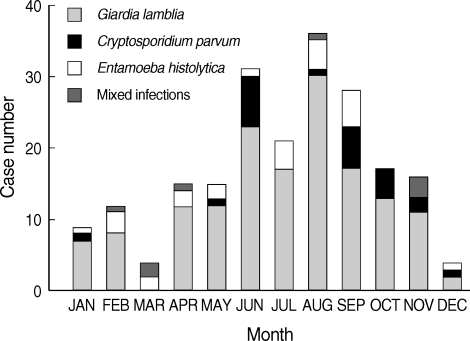Acute diarrhea is one of the most common childhood illnesses in both developing and developed countries. The etiologic agents of diarrhea include viruses, bacteria, and parasites [1]. Among them, viral infection is the most common cause, followed by bacterial and parasitic infections [2]. Giardia lamblia, Entamoeba histolytica, and Cryptosporidium parvum are the major parasitic agents [1]. Although they are not serious life-threatening parasites, they are still important infectious agents, especially to infants. Most survey reports on gastroenteritis outbreaks in South Korea have mainly focused on viral and bacterial infections [3-6], while gastroenteritis caused by intestinal protozoan parasites has not been well studied. We describe here the distribution of intestinal protozoan parasites causing gastroenteritis and variations with patient age and seasons.
This epidemiologic survey was performed for 3 years in Gyeonggi-do (province) of South Korea. In this province, a region located around the capital city of Korea, approximately 11 million people, 25% of the country's population, lives. A total of 6,071 stool specimens were collected from patients with gastroenteritis in 6 general hospitals in Gyeonggi-do during 2004-2006. Cysts of G. lamblia and E. histolytica, and oocyusts of C. parvum were detected by antigen detection ELISA specific for Cryptosporidium, Giardia, and E. histolytica/dispar (IVD Research, Carlsbad, California, USA).
Of the 6,071 patients, 54.7% were below 5 years of age. The intestinal protozoans were detected in 208 (3.4%) samples. The detection rate increased annually, from 1.7% (47/2,739) in 2004 to 4.0% (67/1,675) in 2005 and to 5.7% (94/1,657) in 2006. One of the reasons might be the improvement of diagnostic skills each year. The most predominant parasite species was G. lamblia (152 cases; 2.5%), followed by Entamoeba histolytica (25 cases; 0.4%), Cryptosporidium parvum (23 cases; 0.4%), and mixed infections (8 cases; 0.1%). Mixed infections represented Giardia/Entamoeba, Cryptosporidium/Giardia, and Cryptosporidium/Giardia/Entamoeba. The yearly distributions showed that G. lamblia was the most prevalent species throughout the 3 years (Fig. 1).
The distribution of parasitic agents according to age is shown in Fig. 2. Of the total number of detected samples, 23.1% (48 of 208) were obtained from adults aged 21 years of age and older, while 69.2% (144 of 208) were obtained from children 5 years of age and younger. Of the latter, 43.3% (90 of 208) of the positives were obtained from infants less than 1-year-old. The majority of mixed infections were found in under 5-year-old children. All parasitic co-infections were infected with G. lamblia.
The incidence in winter and spring months (December-May) and summer and autumn months (June-November) were 28.4% and 71.6%, respectively (Fig. 3). The total prevalence in summer-autumn was 2.5 times higher than that in winter-spring. G. lamblia was detected throughout the year, with detection rate being higher in summer-autumn, while E. histolytica and C. parvum were rarely detected in winter (December-May). Bacterial agents have been detected frequently in summer and autumn like parasitic infections, whereas viral gastroenteritis is prevalent in the winter-spring season [6,7].
Presently, parasitic infections causing gastroenteritis were a special concern to children aged less than 5 years. This is consistent in many studies which have shown that children under 5 years of age are the most vulnerable to parasitic gastroenteritis worldwide [8,9]. In our study, G. lamblia was the most prevalent etiologic agent, consistent with the worldwide trend [8]. We regret that morphological identification of G. lamblia and E. histolytica cysts, and of C. parvum oocysts, was not performed in positive samples. However, our results may indicate usefulness and feasibility of the antigen detection ELISA for surveys of intestinal protozoan infections using fecal samples.
We also detected co-infections with parasites and viruses. The viral agents included rotavirus, adenovirus, astrovirus, and norovirus, which are the major viral etiologic agents of gastroenteritis. The viruses were detected using PCR for adenovirus and reverse transcription-PCR for astrovirus, rotavirus, and norovirus [10-15]. The co-infections rates with viruses and G. lamblia, E. histolytica, C. parvum, or mixed infections were 27.6% (42/152), 32.0% (8/25), 47.8% (11/23), and 75.0% (6/8), respectively. Among 6,071 stool specimens, at least 1 viral agent was detected in 30.0% (1,819/6,071) of the stool samples. Among these, rotavirus was the most numerous (53.5%), followed by norovirus (12.6%), astrovirus (7.3%), and enteric adenovirus (0.3%) [16]. The etiologic agents for diarrhea of the rest (66.6% of stool specimens) were unknown.
The present study was a comprehensive longer-term (3 years) investigation of etiologic agents causing parasitic gastroenteritis in South Korea. While useful, the full impact of the study was blunted by the manner of specimen collection. Although stool specimens were collected from the patients with gastroenteritis, there might be some unidentified cases. Thus, our prevalence and incidence numbers might be lower than the total cases of parasitic gastroenteritis in the community. Parasitic contamination in water and foods may escape detection because the food standard regulations are usually limited to bacterial and viral contaminations. Nowadays many foods are imported from foreign locations globally. Hence, foreign-derived parasitic agents might be circulating in the market. Therefore, surveillance of parasitic pathogens should be constantly performed to monitor circulating parasitic agents in the community.









